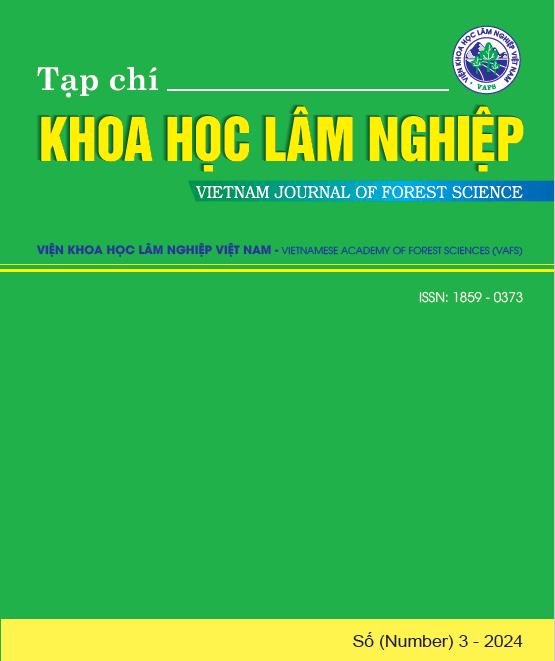STRUCTURAL CHARACTERISTICS AND CARBON ABSORPTION CAPACITY OF Rhizophora apiculata Blume PLANTATION IN CAN GIO BIOSPHERE RESERVE, HO CHI MINH CITY
Keywords:
Rhizophora apiculata, structure, carbon absortionAbstract
The study of the structural characteristics and carbon sequestration of Rhizophora apiculata stands in Can Gio Mangrove Forest Biosphere Reserve was conducted in 2023. The objectives were to assess structural characteristics of R. apiculata stands, quantify carbon accumulation, estimate CO2 sequestration on different age groups stands. The study Six permanant sample plots (1.0 hectare each ) were established of R. apiculata plnatation planted from 1976 to 2000 and divided in different age groups: I (23 - 27 years old); II (28 - 32 years old); III (33 - 37 years old); IV (38 - 42 years old); V (43 - 47 years old); and R. apiculata natural regeneration. Five subplots (each was 500 m2) consisting of four corner subplots and one central subplot were established within each permnant sample plot. The results showed that: (i) R. apiculata stands in Can Gio had an average density from 844 to 3,700 trees/ha, mean diameter at 1.3 m hight from 9.8 to 18.7 cm, mean height from 13.9 to 20.4 m, and stand volume from 230 m3/ha (III age group) to 378.40 m3/ha (V age group); (ii) The Weibull distribution function fifted to modeling the distributions of trees diameter and height across age group. Stand structure in terms of trees diameter distribution was gradually stabilizing in V age group and naturally regenerated stands, while stand structure in terms of tree height distribution was the most stable in II and III age groups; (iii) Aboveground and underground carbon stocks were the highest in V age group, about 211.86 ton/ha, the lowest in II age group about 146.9 ton/hectare and R. apiculata natural regeneration reached 156.29 ton/hectare. Aboveground and underground absortion of CO2 was the highest in V age group about 776.82 ton/hectare and the lowest absortion in III age group about 538.65 ton/hectare. For R. apiculata natural regeneration was 537.05 ton/hectare.
References
Phạm Thế Dũng, 2011. Đánh giá chất lượng rừng Đước (Rhizophora apiculata) trồng thuần loại, đề xuất các giải pháp kỹ thuật lâm sinh và cơ chế quản lý nhằm phát triển bền vững rừng phòng hộ Cần Giờ. Báo cáo tổng kết đề tài, Sở Khoa học và Công nghệ thành phố Hồ Chí Minh.
Kiều Tuấn Đạt, 2023. Nghiên cứu trẻ hóa rừng, nâng cao giá trị, sức chống chịu của rừng phòng hộ Cần Giờ. Báo cáo giám định đề tài. Sở Khoa học và Công nghệ thành phố Hồ Chí Minh.
Huỳnh Đức Hoàn, Bùi Nguyễn Thế Kiệt, Cao Huy Bình, Viên Ngọc Nam, 2018. Sinh khối của quần thể Đước đôi (Rhizophora apiculata Blume) trồng tại khu dự trữ sinh quyển rừng ngập mặn Cần Giờ, thành phố Hồ Chí Minh. Tạp chí Khoa học Lâm nghiệp, số 4/2018.
Huỳnh Đức Hoàn, Bùi Nguyễn Thế Kiệt, Phan Văn Trung, Viên Ngọc Nam, 2018. Trữ lượng carbon của quần thể Đước đôi (Rhizophora apiculata Blume) trồng tại khu dự trữ sinh quyển rừng ngập mặn Cần Giờ, thành phố Hồ Chí Minh. Tạp chí Nông nghiệp và Phát triển nông thôn, số 24/2018.
Phạm Quang Thu, 2011. Nghiên cứu, điều tra tình hình sâu bệnh hại cây Đước (Rhizophoza apiculata), cây Mấm trắng (Avicennia alba) rừng ngập mặn Cần Giờ Thành Phố Hồ Chí Minh và đề xuất quản lý dịch hại. Báo cáo tổng kết đề tài, Sở Khoa học và Công nghệ thành phố Hồ Chí Minh.









